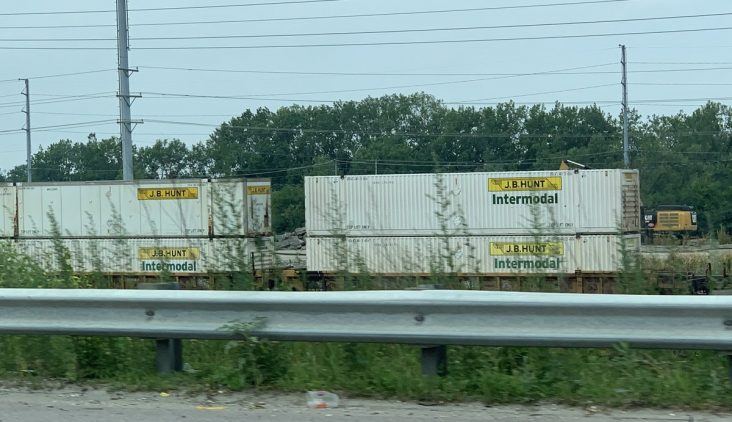Railroad exec highlights benefit of truck-to-rail freight conversion
by December 2, 2021 1:06 pm 1,327 views

Shippers who want to reduce transportation expenses might look to other modes, such as intermodal, amid the high cost to deliver goods via truck, a railroad executive said.
In a recent Stephens conference, Kevin Boone, executive vice president of sales and marketing for Jacksonville, Fla.-based CSX, spoke about inflation, labor issues and freight conversions from truck to rail.
The company’s existing freight volumes are meeting expectations, said Boone, noting that its automotive volumes are improving after a slow start early in the fourth quarter. Its intermodal freight volumes in the United States are flat from the previous quarter amid chassis, truck, warehouse and labor issues in the industry. He added that domestic intermodal volumes are down, while they are up internationally.
“You see the port volumes… And we’ve done a great job from an intermodal network handling that volume, remaining fluid and are ready for the peak season,” he explained. “Things have kicked off early here on the peak season, and things are going very, very well.”
He also said coal volumes have risen, and that customer coal inventories are low and will need to be replenished over the next year. He added that coal volumes have risen amid high natural gas prices, and customers have increased coal use as it’s become more economical compared to natural gas.
According to the Association of American Railroads, U.S. railroads originated 917,787 carloads in November, up 2% from the same month in 2020. The railroads also originated 1.02 million containers and trailers in November, down 9.6% from the same month in 2020. Combined, the rail volumes declined by 4.5% to 1.94 million carloads, containers and trailers. Between January and November, combined rail volumes have risen by 6.7% to 23.79 million carloads and intermodal units, from the same period in 2020.
“Fifteen of the 20 carload categories we track have seen year-to-date carload increases on U.S. railroads through November,” said John Gray, senior vice president of the Association of American Railroads. “Coal leads the way, with carloads up more than 11%, or nearly 306,000 carloads, mainly because the price of natural gas to electricity generators has doubled since the beginning of the year. Chemicals, grain and commodities related to steelmaking have also all showed solid carload growth this year.”
In 2022, Boone said he expects to see a net increase in its employee numbers to handle demand as a labor shortage has started to ease for the company.
“That’s a positive,” he added. “I would say I feel better about it than I did three months ago in terms of our ability to go out and find additional labor.”
Asked about getting back to pre-pandemic employment levels, Boone said he expects to see improvement in the second quarter of 2022 and into the second half of next year.
“We want to move more freight. There’s no question about it,” he said. “We have a good outlook. We have a good visibility to that. We’ve got to make sure the conversion rates on these new employees are very high. And that we make sure they’re getting qualified, and they’re out running on the trains.”
One of the company’s goals has been to convert more freight from trucks but competing for it has been challenging amid the pandemic. He noted that customer fluidity has affected this, and when customers get back into a more regular cadence, this should help the company run trains to the preferred schedules.
“It’s all about taking freight from the trucks,” he said. “We have to be more truck-like in transit times. We’re never going to be as fast, but we have to be closer. And the reliability has got to be there as well.”
The company is starting to see more stability from warehouses regarding drayage and international intermodal, said Boone, adding that containers remain in warehouses longer than they used to, contributing to capacity issues domestically.
“There are not as many boxes to put back on our railroad to move freight,” he explained. “That’s been one of the areas that’s weighed on our growth on the domestic intermodal side. There’s no reason our business shouldn’t be growing there with all of the demand that’s in the market right now, but it’s not.”
Boone said volumes are below 2019 levels, and the supply chain issues have limited volume growth.
Still, he said prospective customers are looking more to rail transportation as freight costs rise. He noted that price inflation is likely here to stay, and customers are looking at ways to offset costs by transporting their freight on rail.
He said times of higher inflation likely benefit the company more as opposed to when inflation is low.
“What we offer is a low-cost alternative to truck,” said Boone, noting that customers haven’t been compelled to look at freight modes other than truck while inflation was low. “Now inflation is here, and I think we’re seeing it through … many of our customer discussions that they’re looking for ways to offset significant cost increases that they’re anticipating next year.”
The company renews a significant number of its customer contracts in the fourth and first quarters annually, and it’s working with them on pricing as it balances volume and price.
“We want to obviously maximize operating income growth — get a fair return on that,” he said. “We want to reach new markets that we haven’t reached before. We want more wallet share of our customer. That means a lot more volume on the railroad hopefully. We have the resources. We have the infrastructure to deliver on that, and we’re soon going to have the people.”
